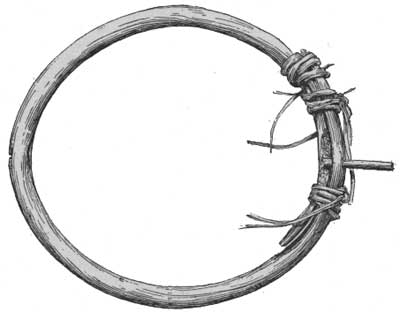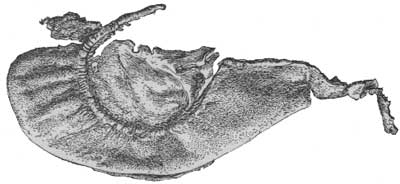MINOR ANTIQUITIES
(continued)
CORN, BEANS, AND SQUASH SEEDS
All indications point to maize, or Indian corn, as
the chief food plant of the prehistoric people of this cliff-dwelling.
This is evident not only from the presence in the ruins of metates and
grinding stones, but also from the abundance of corn ears and other
fragments discovered; corn husks and seed corn were especially plentiful
in rooms and in the refuse-heaps. As in the case of the modern Pueblos,
the corn appears to have been of several colors, while the size of the
cobs indicates that the ears were small with but few rows of seeds. In
addition to cobs, fragments of corn stalks, leaves, and even tassels
were found in some of the rooms. Beans of the brown variety, specimens
of which were numerous in one room, were the most esteemed. There were
obtained also stalks and portions of gourds some of which are
artificially perforated, as well as a gourd the rind of which is almost
complete. Apparently these gourds were used for ceremonial rattles and
for drinking vessels. The form suggests that of a Hopi netted gourd in
which sacred water is brought from distant springs for use in the kivas,
or ceremonial rooms.

FIG. 36. Hoop used in hope-and-pole game.
|
HOOP-AND-POLE GAME
It appears from the discovery of a small wooden hoop
in one of the rooms that the prehistoric people of Spruce-tree House
were familiar with the hoop-and-pole game (fig. 36) so popular among
several of our aboriginal tribes. But whether or not the individual hoop
obtained was used in a secular game or a ceremony may be open to
differences of opinion. The author is inclined to connect the specimen
above referred to with basket dances, one of which is called by the Hopi
the Owakulti.a In this dance the hoop is rolled on the ground and the
players throw or attempt to throw darts through it.
aSee figure of Owakulti altar in the
author's account of the Owakulti. Mr. Stewart Culin thus comments on the
"hoop-and-pole" game among Pueblos: "Similar ceremonies or games were
practised by the cliff-dwellers, as is attested by a number of objects
from Mancos canyon, Colorado, in the Free Museum of Science and Art of
the University of Pennsylvania."ÑTwenty-fourth Annual Report of the
Bureau of American Ethnology.
LEATHER AND SKIN OBJECTS
Fragments of leather or dressed skin (fig. 37) were
found in several of the rooms. These are apparently parts of moccasins
or sandals, but may have been pouches or similar objects. A strip of
rawhide by means of which an ax was lashed to its handle was picked up
in the dump, where also was a fragment of what may have been a leather
pouch with a thong of hide woven in one edge. If skins of animals were
used for clothing, as they probably were, but slight evidence of the
fact remains.

FIG. 37. Portion of leather moccasion.
|
ABSENCE OF OBJECTS SHOWING EUROPEAN CULTURE
In the excavations which were necessary to clean out
the rooms of Spruce-tree House no object of European make was
discovered. There was no sign of any metal, even copper being
unrepresented; no object discovered shows traces of cutting by knives or
other implements made of metal. Evidently European culture exerted no
influence on the aborigines of Spruce-tree House.
PICTOGRAPHS
Near Spruce-tree House, as elsewhere on the Mesa
Verde, are found examples of those rock-etchings and other markings
known as pictographs. Some of these represent human beings in various
attitudes, and animals, as deer, mountain sheep, snakes, and other
subjects not yet determined. As seems to be true of the other
rock-inscriptions just mentioned, some of those near Spruce-tree House
are religious symbols, some are totems, while others are mere
scribblings.
These pictographs are so rude that they give little
idea of the artistic possibilities of their makers, while many are so
worn that even the subjects intended to be depicted are doubtful.
The walls of some of the rooms in the Mesa Verde
cliff-dwellings still show figures painted while the rooms were
inhabited. Among these the favorite designs are of triangular form.
The walls of the secular rooms and kivas of
Spruce-tree House were formerly covered with a thin wash of colored sand
which was well adapted for paintings of symbolic or decorative
character. The colors (yellow, red, and white), were evidently put on
with the hands, impressions of which can be found in several places. In
some cases, as with the upper part of the wall painted white and the
lower part red, the contrast brings out the colors very effectively. The
walls of some of the rooms are blackened with smoke.
Among the designs used are the triangular figures on
the upper margin of the dados and pedestals of kivas. Figures similar in
form, but reversed, are made by the Hopi, who call them butterfly and
rain cloud symbols.
Birds and quadrupeds.—Nordenskiöld
(pp. 108-9) thus writes of one of the ancient paintings:
The first of them, fig. 77, is executed in a room at
Sprucetree House. Here too the lower part of the mural surface is dark
red, and triangular points of the same colour project over the yellow
plaster; above this lower part of the wall runs a row of red dots,
exactly as in the estufa at Ruin 9. To the left two figures are painted,
one of them evidently representing a bird, the other a quadruped with
large horns, probably a mountain sheep. [Elsewhere, as quoted on p. 5.
Nordenskiöld identifies these figures as "two birds."] The painting
shown in fig. 78 is similar in style to the two just described.
In this room the dado bears at intervals along its
upper edge the triangular figures already noticed, and rows of dots
which appear to be a symbolic decoration occurring likewise on pottery,
as an examination of the author's collection makes evident.
Square figures.—On the eastern wall of
the same room in which occur the figures of a bird and a horned mammal
there is a square figure on the white surface of the upper wall. This
figure is black in outline; part of the surface bears an angular meander
similar to decorations on some pieces of pottery. Similar designs,
arranged in series according to Mindeleff's figures, form the decoration
band of one of the kivas in Chelly canyon.
The significance of this figure is unknown but its
widespread distribution, especially in that region of the Southwest
characterized by circular kivas, adds considerable interest to its
interpretation.
Terraced figure.—Covering almost the
whole side of a wall north of kiva C and overlooking the plaza of which
this room forms in part the northern wall, is a conspicuous figure
painted white. If we regard the building of which this is a side as
formerly two stories high, this painting would have been on the inside
of a room, otherwise we have the exceptional feature of a painting on an
outer wall. The purpose of this painting is not clear to the author, but
similar figures, reversed, signify rain clouds. The figure recalls in
form a representation of a T-shaped doorway and appears to be a unique
one among Mesa Verde ruins.


